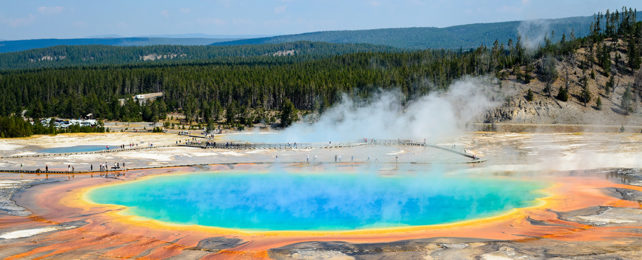The Yellowstone supervolcano in northwest Wyoming isn't just one of the most fascinating places on Earth, it's potentially one of the most volatile, thanks to the reservoir of magma contained within.
A new study by an international team of researchers has determined that there's actually more magma under Yellowstone than was previously thought, adding important details to models that could be used to fine tune our estimates on the next big eruption.
Not that we need to panic. The research also indicates the extra content – though significant – doesn't make an imminent eruption more likely.
Led by geologist Ross Maguire of the University of Illinois Urbana-Champaign, the study sought to determine how much magma Yellowstone's supervolcano contained, and how it was distributed.
In particular, they wanted to identify melt (magma in its liquid form), which is often used to predict eruptions by way of comparing current conditions to those that preceded prior eruptions.
"Although our results indicate that Yellowstone's magma reservoir contains substantial melt at depths that fueled prior eruptions, our study does not confirm the presence of an eruptible body or imply a future eruption," Maguire and colleagues write in their published paper.
Of course peering deep underground isn't easy, but the researchers used a newly developed tomographic imaging technique to analyze seismic wave recordings taken between 2000 and 2018, applying a process known as full waveform inversion to better interpret the bouncing and reflecting vibrations.
Based on how the speed of the measured waves changes at different depths, the researchers estimated the mushy magma reservoir beneath Yellowstone has a partial melt fraction of between 16 percent and 20 percent, compared with previous models estimating 10 percent or less.
The slowest speeds detected in this new study were some 3 to 8 kilometers (roughly 2 to 5 miles) below the surface, suggesting the liquid-melt is most concentrated at these shallow depths.
Previous estimates suggest that somewhere between 35 and 50 percent melt is required to trigger an eruption, though there are a whole host of factors at play that make these events difficult to predict. The researchers say even the latest scanning methods can miss certain pockets of liquid magma.
"The melt fraction we estimated is substantially lower than what would be expected if a large fraction of the Yellowstone reservoir were in the eruptible stage of its life cycle," write the researchers.
"However, the presence of small subset volumes of concentrated silicic melt cannot be ruled out."
The newly detailed melt-rich zone is an "important indicator" of where Yellowstone is in its eruptive cycle, the researchers say, but it's just one part of the picture. Prediction models are being constantly refined as new data comes in and new eruptions happen.
There have been three catastrophic eruptions from Yellowstone in the last 2.1 million years, and while there isn't a whole lot of certainty about when the next one might be, a clearer indication of the geology of the caldera is always going to help.
The area is under constant observation by the United States Geological Survey (USGS) and the Yellowstone Volcano Observatory, which should mean that further warning signs are picked up well in advance.
"Strain events such as new magma intrusions or tectonic deformation that could begin to mobilize and concentrate magma would likely be accompanied by a host of dynamic processes evident to ongoing geophysical and geochemical monitoring," write the researchers.
The research has been published in Science.
